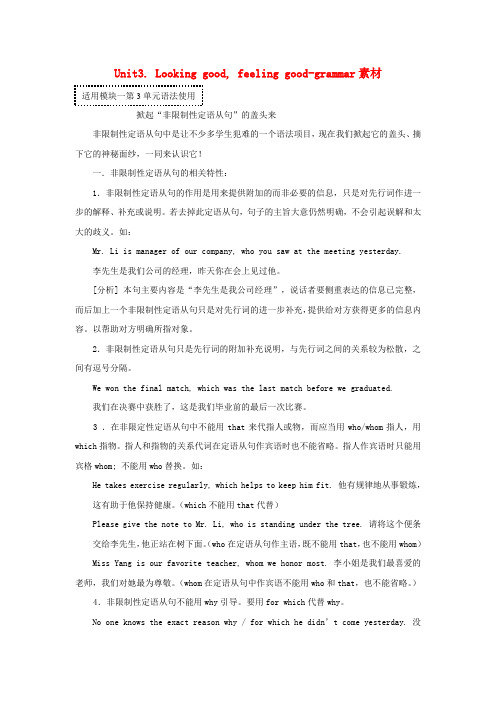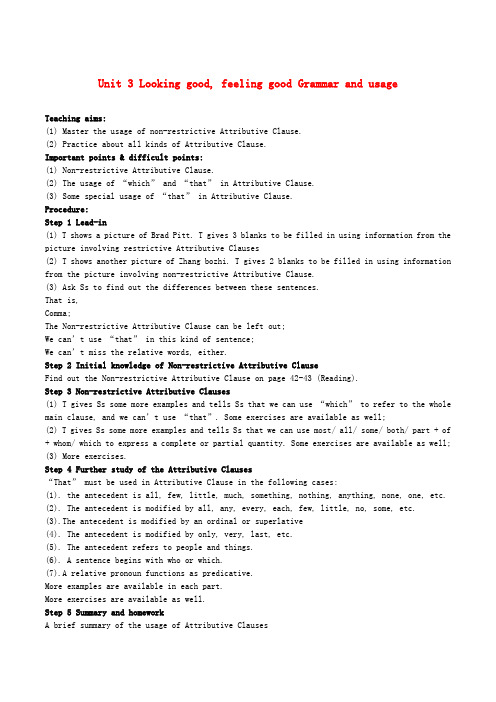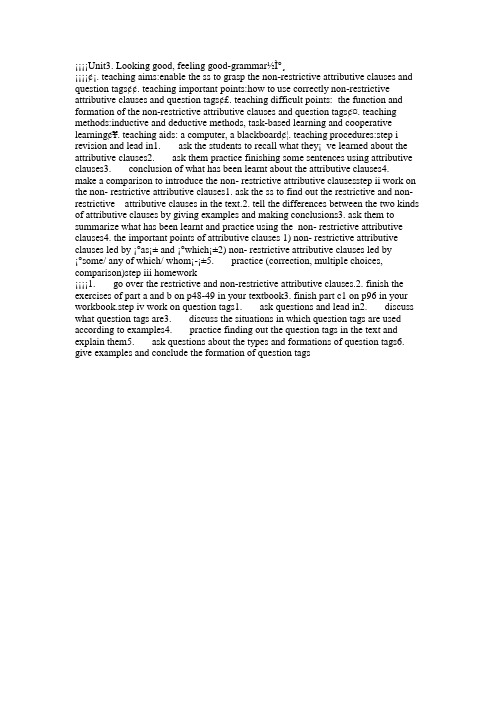Unit 3 Looking good, feeling good grammar and useage II 教学设计-优质公开课-译林版必修1精品
- 格式:doc
- 大小:28.00 KB
- 文档页数:2

如何将核心素养与我们的学科联系起来是一个很重要的问题。
我认为,首先我们应该了解核心素养的本质。
核心素养,是指学生表现在学习和创新中的综合能力,它是人才必备的内在需求。
英语学科核心素养的内涵可以概括为三个方面:语言能力、思维品质、文化意识以及学习能力和情感态度两个关键。
依据这种分类,课堂教学可以从情境、问题和交际三个切入点展开,以“融合”为主线,贯穿学习能力和情感态度的培养与发展,最终促成英语学科核心素养的养成。
众所周知,课堂教学是学习的主阵地。
课程改革的核心环节是课程实施,而课堂是教师专业发展、学生综合素养的平台。
其次,要打造“出彩”的英语课堂,就要充分发挥学生的主体作用。
活泼的学生,非常乐意在教学活动中表达自己的看法,通过生活情境、动画视频、歌谣等形式,烘托出热烈、有趣又具有亲和力的活动氛围,让学生们情不自禁地加入到我们的英语实践中,把学生们这种不由自主的“踊跃”发展为他们良好的学习习惯。
第三,优质高效课堂教学在教学效益方面要求教学目标紧紧围绕实现三维目标和促进学生核心素养发展。
课堂教学效益精准化,一方面需要教师仔细研读相关指导文件,如核心素养框架、学科课程标准及其解读文本,吃透核心素养和学科核心素养的本意,特别是要把握住体现学科本质特征的知识、能力和品格;另一方面,教师需要具备整体的课程观,了解某一阶段学生(学科)核心素养发展的脉络,能够准确定位每堂课的教学内容在学生(学科)核心素养发展中所起的作用,析取出主要的教学目标,并将其作为课堂教学设计和实施的重心。
Unit 3 Looking good, feeling goodLearning aimsKnowledge (知识):Learn the new words and phrases and learn to use the Present Perfect and the Present Perfect Continuous lense1.Ability (能力):Improve (he abilities of reading and writing.2.Emotion (情感):Know the importance of health.Period 1 ReadingStep 1 Pre-classReading1)R ead the text quickly and do part A. on page2)Reading strategy. (Try to answer the questions with your own words.)When we come across 'however' or 'but' between two sentences, we can guess thatCan you make some sentences connected with 4however? or 'bui'?1._________________________________________________________________________2._________________________________________________________________________ 3)Read the article again carefully. Underline (下划线)new words and difficult sentences while reading and then do part C1, C2 and DI on page44 and part D2. and E on page 45What's the meaning of the title “dying to be ihin..."?4)Which method would you prefer, if you are to lose weight? What are the advantages and disadvantages?Going on a dietExercising in a gym1) stay停留,暂住;逗留vi f n.练:医生告诉他,病人还得在医院住两个星期。

Unit3. Looking good, feeling good-grammar素材掀起“非限制性定语从句”的盖头来非限制性定语从句中是让不少多学生犯难的一个语法项目,现在我们掀起它的盖头、摘下它的神秘面纱,一同来认识它!一.非限制性定语从句的相关特性:1.非限制性定语从句的作用是用来提供附加的而非必要的信息,只是对先行词作进一步的解释、补充或说明。
若去掉此定语从句,句子的主旨大意仍然明确,不会引起误解和太大的歧义。
如:Mr. Li is manager of our company, who you saw at the meeting yesterday.李先生是我们公司的经理,昨天你在会上见过他。
[分析] 本句主要内容是“李先生是我公司经理”,说话者要侧重表达的信息已完整,而后加上一个非限制性定语从句只是对先行词的进一步补充,提供给对方获得更多的信息内容。
以帮助对方明确所指对象。
2.非限制性定语从句只是先行词的附加补充说明,与先行词之间的关系较为松散,之间有逗号分隔。
We won the final match, which was the last match before we graduated.我们在决赛中获胜了,这是我们毕业前的最后一次比赛。
3 .在非限定性定语从句中不能用that来代指人或物,而应当用who/whom指人,用which指物。
指人和指物的关系代词在定语从句作宾语时也不能省略。
指人作宾语时只能用宾格whom; 不能用who替换。
如:He takes exercise regularly, which helps to keep him fit. 他有规律地从事锻炼,这有助于他保持健康。
(which不能用that代替)Please give the note to Mr. Li, who is standing under the tree. 请将这个便条交给李先生,他正站在树下面。

Unit 3 Looking good, feeling good Grammar and usageTeaching aims:(1) Master the usage of non-restrictive Attributive Clause.(2) Practice about all kinds of Attributive Clause.Important points & difficult points:(1) Non-restrictive Attributive Clause.(2) The usage of “which” and “that” in Attributive Clause.(3) Some special usage of “that” in Attributive Clause.Procedure:Step 1 Lead-in(1) T shows a picture of Brad Pitt. T gives 3 blanks to be filled in using information from the picture involving restrictive Attributive Clauses(2) T shows another picture of Zhang bozhi. T gives 2 blanks to be filled in using information from the picture involving non-restrictive Attributive Clause.(3) Ask Ss to find out the differences between these sentences.That is,Comma;The Non-restrictive Attributive Clause can be left out;We can’t use “that” in this kind of sentence;We can’t miss the relative words, either.Step 2 Initial knowledge of Non-restrictive Attributive ClauseFind out the Non-restrictive Attributive Clause on page 42-43 (Reading).Step 3 Non-restrictive Attributive Clauses(1) T gives Ss some more examples and tells Ss that we can use “which” to refer to the whole main clause, and we can’t use “that”. Some exercises are available as well;(2) T gives Ss some more examples and tells Ss that we can use most/ all/ some/ both/ part + of + whom/ which to express a complete or partial quantity. Some exercises are available as well;(3) More exercises.Step 4 Further study of the Attributive Clauses“That” must be used in Attributive Clause in the following cases:(1). the antecedent is all, few, little, much, something, nothing, anything, none, one, etc.(2). The antecedent is modified by all, any, every, each, few, little, no, some, etc.(3).The antecedent is modified by an ordinal or superlative(4). The antecedent is modified by only, very, last, etc.(5). The antecedent refers to people and things.(6). A sentence begins with who or which.(7).A relative pronoun functions as predicative.More examples are available in each part.More exercises are available as well.Step 5 Summary and homeworkA brief summary of the usage of Attributive ClausesComplete the exercises on page 48-49.6th period Grammar and usageTeaching aims:(1) Master the usage of non-restrictive Attributive Clause.(2) Review the usage of all kinds of Attributive Clause.(3) Review the usage of intonation, and learn how to read question tags.(4) Learn and master the form of question tags.Important points & difficult points:Some special forms of the question tags.Procedure:Step 1 Lead-inT shows a picture, and tells a story of “shmily”. A old couple keep playing the “shmily” hide and seek game. They write “shmily” on a piece of paper, and hide it in their house. Sometim es, they hide it under a cup, sometimes they hide it under a book. And the meaning of “shmily” is ‘see how much I love you’.T: Do you say “I love you” to your parents? And how do you say it?S: …T: Do your parents say “I love you” to you? If they are too shy to say “I love you” to you, you can ask them, “You love me, don’t you?” and remember, in a rising intonation. When we expect the other person to agree with us, the question tad has a falling intonation.Step 2 Question tagsT introduces the definition of question tags and the basic usage of question tag.(1) We use a negative question tag at the end of a positive statement; we use a positive question tag at the end of a negative statement;(2) Words like neither, none, nobody, nothing, few, little, never, hardly or seldom are considered negative;(3) We use a personal pron. like I, we, you, he, she, it or they in a question tag.(4) We use an auxiliary verb, model verb or be in a question tag.(5) After an imperative clause, we use will you. After Let’s, we use shall we.Some exercises are available as well.Step 3 Language pointsT asks Ss to read out the answers and T introduces the important language points as well. (1). consider考虑consider sth./doing sth.b. consider 认为 +that clause/ sb. to bec. consider as 认为……是……(2). be skinny= be very thin(3). lift weights(4). side effect(5). achievement(6). take the risk(7). read your postStep 4HomeworkP51, A, B; P104, C1, C2。

牛津译林版(2020)必修第一册Unit 4 Looking Good,Feeling GoodGrammar and usage本节课的教材分析:本节课的教材来源于牛津译林版(2020)必修第一册Unit 4 Looking Good, Feeling Good Grammar and usage。
该教材包含了有关外貌与健康的主题,旨在帮助学生提高英语语法和用法。
教材内容丰富,包括课文、语法练习以及听力练习等。
教学目标:1. 知识目标:学生能够掌握一些形容词和副词的比较级和最高级形式的用法,如以-er结尾的比较级,以-est结尾的最高级以及不规则变化的比较级和最高级。
2. 技能目标:学生能够运用所学词汇和语法表达关于外貌与健康的观点和看法。
3. 情感目标:培养学生的英语学习兴趣,增强他们对自己外貌和健康的关注,促进他们形成良好的生活习惯。
教学重点:1. 形容词和副词的比较级和最高级形式的用法。
2. 掌握不规则变化的形容词的比较级和最高级形式。
教学难点:1. 掌握不规则比较级和最高级形式的变化规则。
2. 运用所学词汇和语法表达观点和看法。
学情分析:学生是一年级的学生,对英语语法和用法还不够熟悉,学习英语的动力还比较弱。
他们对于外貌与健康这个主题可能感到比较陌生,对于形容词的比较级和最高级形式的用法不太了解。
他们学习英语的时间较短,需要通过生动、实用的教学方法来提高学习兴趣和提升学习效果。
教学策略:1. 激发学生的学习兴趣:通过选取与学生生活相关的话题、案例和故事来引起学生的兴趣和思考,提高他们对英语的学习兴趣。
2. 创设情境:通过图片、视频等多媒体资源,创设真实的情境,让学生能够身临其境地感受到外貌与健康的重要性,从而积极参与到课堂活动中。
3. 引导发现和探究:通过提问和组织小组讨论等方式,引导学生自主思考、发现规律,并培养他们的问题解决能力和合作精神。
教学方法:1. 任务型教学法:通过多种任务设计,让学生在实际情境中运用所学知识解决问题,培养学生的实际运用能力。

Unit 3 Looking good, feeling goodPeriod 5 Grammar 2一.[设计思想]从生活中常见的反意疑问句入手,让学生掌握反意疑问句要注意的考点,再附以练习作为巩固。
二.[教学目标]By the end of this class, the students will be able to1. master the basic forms of question tags.2. master the usage of Question tags and use them correctly and properly. 三.[教学重难点]Master the usage of Question tags and use them correctly and properly. 四.[教学环节][课堂导入]Translate the following sentences into Chinese orally.1. You will go to the gym every day, won’t you?2. You still go to the library every day, don’t you?3. She studies hard, doesn’t she?4. She studied hard, didn’t she?5. He can’t swim, can he?[预习检查]Introduction of Question Tags〔Read Question Tags on P50 〕1. 什么叫反意疑问句?反意疑问句又叫附加疑问句,是指当提问的人对前面所表达的事实不敢肯定,又需要向对方加以证实时所提出的问句。
2. 反意疑问句的作用:Question tags are used to ask for agreement or confirmation.3. 反意疑问句通常是由一个,加上一个省略形式的构成。

¡¡¡¡Unit3. Looking good, feeling good-grammar½Ì°¸¡¡¡¡¢¡. teaching aims:enable the ss to grasp the non-restrictive attributive clauses and question tags¢¢. teaching important points:how to use correctly non-restrictive attributive clauses and question tags¢£. teaching difficult points: the function and formation of the non-restrictive attributive clauses and question tags¢¤. teaching methods:inductive and deductive methods, task-based learning and cooperative learning¢¥. teaching aids: a computer, a blackboard¢¦. teaching procedures:step i revision and lead in1. ask the students to recall what they¡¯ve learned about the attributive clauses2. ask them practice finishing some sentences using attributive clauses3. conclusion of what has been learnt about the attributive clauses4. make a comparison to introduce the non- restrictive attributive clausesstep ii work on the non- restrictive attributive clauses1. ask the ss to find out the restrictive and non- restrictive attributive clauses in the text.2. tell the differences between the two kinds of attributive clauses by giving examples and making conclusions3. ask them to summarize what has been learnt and practice using the non- restrictive attributive clauses4. the important points of attributive clauses 1) non- restrictive attributive clauses led by ¡°as¡± and ¡°which¡±2) non- restrictive attributive clauses led by¡°some/ any of which/ whom¡-¡±5. practice (correction, multiple choices, comparison)step iii homework¡¡¡¡1. go over the restrictive and non-restrictive attributive clauses.2. finish the exercises of part a and b on p48-49 in your textbook3. finish part c1 on p96 in your workbook.step iv work on question tags1. ask questions and lead in2. discuss what question tags are3. discuss the situations in which question tags are used according to examples4. practice finding out the question tags in the text and explain them5. ask questions about the types and formations of question tags6. give examples and conclude the formation of question tags。
Unit3. Looking good, feeling good-grammar测试满分:100分时间:40分钟一、用所给动词的适当形式填空(共10分,每小题1分)1. I ______________ (not hear) from my friend for months.2. _______ (look) is important for women, I think.3. Well done, that is it, keep ________ (go).4. I really do not know which sport ____________ ( choose).5. I was ________ (excite) at the _________ (excite) news just now.6. How about ________ (try) to do aerobics tomorrow?7. This is the only article of these that ______ (be) written by him.8. That is one of those books that ________ (be) worth reading.9. Tell her ___________ (not take) weigh-loss pills because they are bad for your health.10. I am a good student, __________ (be not) I?二、单项选择(共20分,每小题1分)1、Do you know the reason he was late?A.for which B.for what C.which D.that2、has been said above, grammar is a set of dead rules.A.As B.That C.What D.Which3、John got beaten in the game, had been expected.A.who B.what C.that D.as4、They’ve invited me to their party, is kind of them.A.this B.that C.which D.as5、Crusoe’s dog became ill and died, made him very lonely.A.this B.that C.which D.as6、There isn’t so much noise in the country in big cities.A.as B.where C.which D.that7、I often thought of my childhood, I lived on a farm.A.who B.when C.where D.which8、Next month, you’ll be in your hometown, is coming.A.where B.when C.that D.which9、The next thing must be done is to make a plan.A.which B.that C.when D./10、He talked happily about the men and books interested him greatly in the school.A.that B.when C.who D.which11、I still remember the day she first wore that pink dress.A.on which B.on that C.in which D.which12、Do you know the reason she got so angry yesterday ?A.why B.which C.for that D.for why13、Is some German friends visited last week ?A.this school where B.this school oneC.this the school D.this school14、Is there any one in your class family is in the city.A.whose B.which C.who’s D.who15、Can you lend me the book the other day ?A.which you talked B.that you talkedC.about that you talked D.you talked about16、This is one of the best films this year.A.which has been shown B.that have been shownC.that have shown D.have been shown17、Do you know the man ?A.that I spoke B.I spoke toC.to who I spoke D.whom I spoke18、There are two thousand students in our school, are girls.A.two-thirds in which B.two-thirds in themC.two-thirds of them D.of whom two thirds19、I have bought two ball-pens, writes well.A.neither of them B.none of themC.neither of which D.none of which20、He built a telescope he could study the skies.A.by it B.through which C.with that D.in which三、单句改错(共10分,每小题1分)1. He told us about the countries where he had visited.2. Egypt is a country where is famous for its pyramids.3. China is the country where he spent the best part of his life.4. The days when we spent together cannot be easily forgotten.5. The house stands at the place that the two roads meet.6. We shall visit the college where his father teaches there.7. I know the reason that she looks so worried.8. He left me the book, that is very useful for me.9. This is the room which food is kept.10. April 15, 1976 is the day when we’ll never forget.四、在下列空格中填入适当的关系代词或关系副词。
单元:Unit 3 Looking good, feelinggood板块:Grammar and Usage (Question tags)Thoughts on the design:本单元的第二个语法项目是反意疑问句。
笔者采取了从情景对话、规则到语感的高中英语语法教学思路。
强调了情景化的对话呈现、对比体验式的语法规则讲解,尤其是语感形成在英语语法教学中的重要作用。
针对本单元的语法项目进行有效教学,首先选取能激发学生兴趣的素材,考虑它的趣味性、情景性和实用性。
趣味性是指该素材能吸引学生的注意力,让他们产生学习兴趣;所谓情景性是指该素材应借助于一定的情景,有助于激发学生的想象力;实用性是指该素材包括本单元的语法项目,重点突出,又简单易懂。
附加疑问句的语调在具体的语境中起着至关重要的作用,所以本节课开始时借助于简单的课堂用语,既引出附加疑问句的类型,同时也运用正确的语调把要介绍的信息传达给学生。
借助与对话情景呈现所要教学的语法项目,让学生在故事或对话情景中体会和领悟语法规则,进而通过老师的引导、分析和适当的练习,巩固所学习的语法项目,最终达到语法规则运用自动化。
在本节课的巩固环节中充分利用现有教材资源并加以改编,让语法在一定的情景中进行操练,最后再通过让学生反复阅读,强化语感的培养和形成。
Teaching aims:1. After reviewing the usage of intonation, the students will be able to learn howto read question tags;2. After learning the forms of the question tags, the students will learn whatquestion tags are, and in what situations they are used;3. They will be told how to use different intonations at the end of the sentences to express different meanings, and how to form question tags.Teaching procedures:Step 1 Lead-inGood morning. The bell isn’t ringing, is it? Let’s have a free talk. Today I’m wearing a new dress. I want to feel good and look good. I also find one of you wearing a new sweater.He is very smart, isn’t he? OK, the bell is ringing, isn’t it? Le t’s begin our class, shall we?Today we’ll learn question tags.1.肯定的陈述句+否定的附加疑问句。
Unit 3 grammar and usage II 教学设计Teaching aims:
1. Review the usage of intonation,and learn how to read question tags.
2. Learn and master the form of question tags.
Teaching important and difficult points:
Some special forms of the question tags.
Teaching methods:
Task-based method & Communicative method
Teaching procedure:
Step 1 Lead-in
shows a picture,and tells a story of “shmily”. An old couple keep playing the “shmily” hide and seek game. They write “shmily” on a piece of paper,and hide it in their house. Sometimes,they hide it under a cup,sometimes they hide it under a book. And the meaning of “shmily” is …see how much I love you‟.
T: Do you say “I love you” to your parents?And how do you say it?
T: Do your parents say “I love you” to you?If they are too shy to say “I love you” to you,you can ask them,“You love me,don‟t you?” and remember,in a rising intonation. When we expect the other person to agree with us,the question tag has a falling intonation.
Step 2 Question tags
introduces the definition of question tags and the basic usage of question tag.
(1) We use a negative question tag at the end of a positive statement;we use a positive question tag at the end of a negative statement;
(2) Words like neither,none,nobody,nothing,few,little,never,hardly or seldom are considered negative;
(3) We use a personal pron. like I,we,you,he,she,it or they in a question tag.[ (4) We use an auxiliary verb,model verb or be in a question tag. (5) After an imperative clause,we use will you. After Let‟s,we use shall we.
Step3 practice
Step 4 Language points
1. consider
a. 考虑consider sth./doing sth.
b. consider sb. to be
c. consider as 认为……是……
2. take the risk
risk doing sth. 冒险做某事Step 4 Homework
P51,A,B;P104,C2。